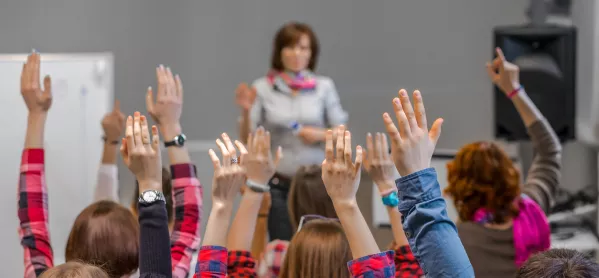- Home
- Coronavirus: how to handle larger classes
Coronavirus: how to handle larger classes

As part of the management plan for coronavirus, schools may be asked to group students into larger classes if teachers come down with the virus and are unable to attend school.
We asked Amy Forrester, Tes behaviour columnist, English teacher and director of pastoral care (key stage 4) at Cockermouth School in Cumbria, for her view.
What is your biggest issue with the plan?
Teaching large groups of students, potentially 50-60 at a time, is going to have an impact on how we deliver content and ensure that all students can learn.
More active activities, such as group work, are going to be nigh-on impossible.
Teachers will need to carefully consider their delivery and use more explicit instruction approaches. It may be pertinent to consider what resources you have on hand - a visualiser can really help with this style of teaching, for example - but there will also be a need to consider the physical environment.
Exams: Ofqual braces for exam disruption due to coronavirus
Coronavirus: How to keep teaching if schools are closed
Video learning: Can YouTube help to teach your GCSE classes?
In order to approach this successfully, it may be appropriate for leadership teams to provide some interim training for staff so that they can agree on what teaching styles are to be used and collectively work on the challenges they may face. This will help everyone to feel as confident as they can in what will, no doubt, be a very difficult process.
What challenges will there be with managing behaviour?
One of the biggest areas to consider will be managing behaviour. In large groups, in potentially crammed spaces, the challenges are going to be varied and, in all probability, complex.
Where you might usually have had more challenging students in smaller groups, keeping particular young people apart, this may no longer be possible. It may be appropriate for school leaders to identify where they can bring in support staff to ensure that there are enough adults in the room to manage behaviour. Finding support in the system, even if that needs to come from admin staff, will be vital in keeping learning disruption-free.
School leaders may also need to consider having some clear, concise rules for students to follow coupled with clear sanctions. There is no room for grey areas in this situation.
In addition, they may need to consider how to manage the removal of disruptive students - when the class size is doubled, the impact of poor behaviour on the rest of the class is greater, as is the potential for the behaviour to spread.
Leaders will need to ensure that there is someone to call on in these situations and someone assigned to any spaces used as removal rooms.
Students will need to be clear about the rules and any changes to normal practice - the best way to do this will be through clearly communication with young people but also their parents to ensure everyone knows and understands when things are different from how they normally would be.
How can we manage the logistics?
School leaders will need to identify all the large spaces that they can, such as gyms, school halls or assembly venues. It may also be pertinent to explore what spaces the local community may be able to provide if they are close by, such as church halls or community centres.
In large venues, key year groups close to examinations can take priority.
Once you know what staffing you do have, deploying these to GCSE and A-level examination groups will be vital. This may require suspension of the normal timetable.
Schools will need to consider which parts of courses and curriculum are applicable to all students and which aren’t. This can then be timetabled around venues and staffing to ensure the best coverage. It could include, for example, an English teacher teaching content applicable to all students en masse, followed by smaller sessions later in the day/week for options subjects.
Of course, there are many students who are not in examination years. This will need to be managed around the needs and priorities of those who are sitting examinations imminently.
How can we meet individual students’ needs?
In this situation, meeting individual students’ needs will be a challenge. Teachers should be provided with information about students’ special educational needs and disabilities (SEND) and prior attainment. This will likely result in some real mixed-ability teaching.
For some staff, this will be a huge challenge and school leaders should consider providing training. Teaching to the top and supporting upwards will be important to ensure that all students continue to be challenged academically, but teachers will also need to give consideration to supporting lower-attaining students in this kind of environment.
It will be easy for students to get lost in large groups and school leaders will need to plan for this, as well as to ensure that students with an education, health and care plan are well supported.
Amy Forrester is Tes behaviour columnist, English teacher and director of pastoral care (key stage 4) at Cockermouth School in Cumbria
Keep reading for just £1 per month
You've reached your limit of free articles this month. Subscribe for £1 per month for three months and get:
- Unlimited access to all Tes magazine content
- Exclusive subscriber-only stories
- Award-winning email newsletters



